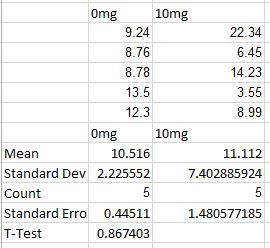BME100 f2014:Group7 L2
| Home People Lab Write-Up 1 | Lab Write-Up 2 | Lab Write-Up 3 Lab Write-Up 4 | Lab Write-Up 5 | Lab Write-Up 6 Course Logistics For Instructors Photos Wiki Editing Help | |||||||
|
OUR TEAM
LAB 2 WRITE-UPDescriptive StatisticsExperiment 1
ResultsExperiment 1 T-test: p-value = 0.867403
AnalysisExperiment 1
Experiment 2
Summary/DiscussionBoth of these experiments were designed to test the effect of LPS on Inflammotin. In the first experiment, two groups of rats were tested with a control group at 0mg and the test group receiving 10mg of Lipopolysaccharide. The t-test revealed that there was no significant correlation between the levels of LPS and Inflammotin in rats (0.867 is less than 0.95). In the second experiment, four groups of humans were tested with levels of LPS including 0mg, 5mg, 10mg and 15mg. A single factor ANOVA test was run to determine whether or not the data revealed a statistically significant correlation between LPS and Inflammotin. Because the p-value returned from the anova test was nearly zero (1.4E-16) we can say with very high confidence that LPS does affect the level of Inflammotin in humans. If the human experiment had been conducted in the same manner as the rat study was, we would not have sufficient information to draw this conclusion. |
|||||||





